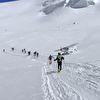Gran Sasso d'Italia and the Paretone Fourth Pillar. By Ivo Ferrari

 1 / 3
1 / 3 Ivo Ferrari
Ivo Ferrari
Fabrizio told me the story of the first repeat of the, at the time, dreaded via Mario - Caruso up the Fourth Pillar. I listened carefully, my mind traveling image I consider "beautiful" and emblematic... then the book of Stefano did the rest, he told the story of the centre of Italy that sometimes, unfairly, lives beneath the shadow of the great alpine faces ... UNJUSTLY!
THE
HISTORY OF ALPINISM IN ABRUZZO (Ricerche & Redazioni)
courtesy of Stefano Ardito
"... For Gigi, however, the real problem was solving the Fourth Pillar. The steepest, most difficult, coldest. In September 1959, together with Caruso, Gigi reached the Paretone from Rifugio Duca degli Abruzzi. Pegs, carabiners and etriers weighed their rucksacks down. It was cold, as they approached the base they noticed icicles dripping off the rock. Two cold and unpleasant pitches let to the open chimney with its smooth walls where placing protection proved difficult.
Emilio tried to take the lead, but he was slow. Gigi, who felt stronger than ever before, shouted at him to descend, he lowered him to the belay and set off, like a rocket. "Gigi was almost in a trance" recounted Caruso. Things really got tough at this point. Climbing free, placing “extremely dodgy pegs”
Where the cracks ended, he hooked up small pockets and clipped in to his aiders. What pushed him upwards, he would later tell, was "a desire I’d never had before." Gigi Mario was twenty-one years old, was an exceptional climber, on great form. But that pitch took him more than two hours. Emilio, who seconded, had to helped with the rope from above. At the top the pillar gave way to a maze of ledges, chimneys and cracks. From the summit, the two raced down to Campo Imperatore because the cable car stopped at 17.20 and they had return to Rome on their Lambretta, the next day they had to work... "
FIRST REPEAT OF THE FOURTH PILLAR ON PARETONE
courtesy of Fabrizio Antonioli
Although almost forty years have passed, I still remember it all clearly. It was in July 1977, a unforgettable season for me who’d only encountered the Rome’s mountaineering two years previously. The exciting environment of mountaineers and climbers, the difficult crags such as Gaeta, Leano and Circeo had rapidly left their mark. We were a well-balanced trio (Frezzotti, Cutolo and I) and we were drawn to repeating one of the masterpieces of Gigi Mario: his unrepeated route up the Fourth Pillar of the Gran Sasso.
The hut warden at Rifugio Franchetti, Pasquale Iannetti, had welcomed us in and, when he learned about our objective, woke up at 5 am to prepare breakfast. We set off in first light; up via the series of ledges to the base of the West Face to then look out onto the Paretone, less than 200 meters below the summit of the Vetta Orientale, the eastern summit. As all those who know the Paretone well, a complex part of the ascent it the descent. The first rays of the sun warmed us and we began down climbing the magnificent slabs of the deep Canale Iannetta that diagonally splits the Paretone in two. The rock was warm and dry, the Abruzzo region unfolded below and the sea in the distance provided pleasure.
The Fourth Pillar is the first you reach as you descend, the others are reached by continuing on down. We crossed a snowfield and reached the base. The route, first climbed by Mario and Caruso in 1959, had had no repeats in 18 years, partly because of difficulties by the first ascentionsits had encountered. The guidebook stated that "the crux (grade VI and A3) consisted in an overhanging corner and crack that is very difficult to protect.” Gigi Mario had said that it was an extremely difficult pitch with little pro and that he’d used aiders with "meat hooks…” I had with me some rudimentary skyhooks and aiders, but in particular I had the first nuts from England. I’d chosen Galibier boots and not Superga (introduced to Rome’s mountaineering world only a few months previously by Pierluigi Bini) above all for the cold that came from the mythical bamboo. I remember my shouts of joy at the top of the crux pitch that, for the record, I’d climbed without aiders.
by Ivo Ferrari
Quarto Pilastro del Paretone Gran Sasso
Via Luigi Mario and Emilio Caruso 1959
First repeat: Fabrizio Antonioli, Massimo Frezzotti and Paolo Cutolo 1977
First winter ascent: Marco Marziale and Luciano Mastracci 1995



 Copia link
Copia link























